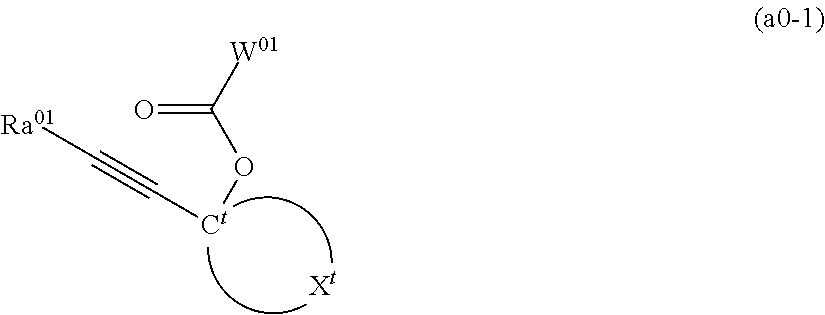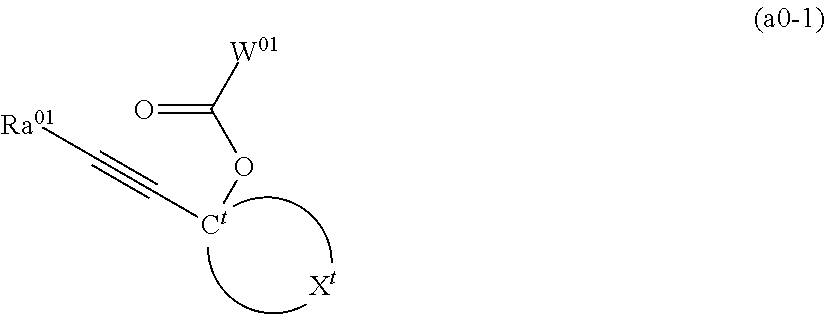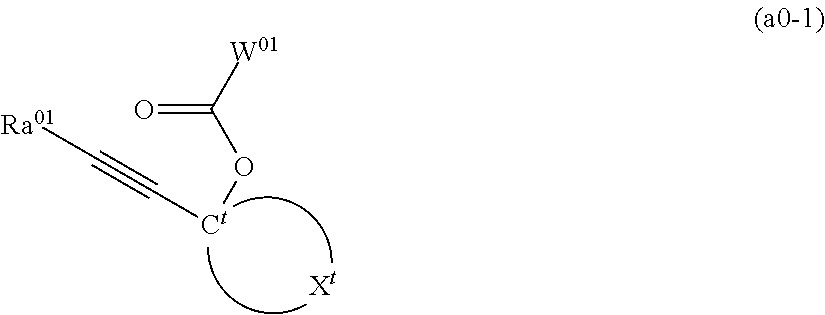Resist composition and method of forming resist pattern
a resist composition and composition technology, applied in the direction of microlithography exposure apparatus, photomechanical equipment, instruments, etc., can solve the problem of difficulty in achieving all of the above characteristics
- Summary
- Abstract
- Description
- Claims
- Application Information
AI Technical Summary
Benefits of technology
Problems solved by technology
Method used
Image
Examples
synthesis example 1
of Polymeric Compound
Synthesis Example of Polymeric Compound (A-1)
[0826]18.9 g of a monomer (m-a0-1), 10.0 g of a monomer (m-a10-1 pre), and 3.86 g of azobis (isobutyric acid) dimethyl (V-601) as a polymerization initiator were dissolved in 43.6 g of methyl ethyl ketone (MEK) to prepare a dropping solution. 11.6 g of MEK was added to a three-necked flask connected with a thermometer, a reflux tube, and a nitrogen feeding tube, heated to 85° C. in a nitrogen atmosphere, and the above dropping solution was added dropwise over 4 hours. After completion of the dropwise addition, the reaction solution was stirred at 85° C. for 1 hour. Then, the reaction solution was cooled to room temperature. Next, 12.2 g of acetic acid and 175 g of methanol were added to the obtained polymerization solution, and a deprotection reaction was carried out at 30° C. for 8 hours. After completion of the reaction, the obtained reaction solution was precipitated in 2,600 g of heptane, followed by washing. The ...
synthesis examples 2 to 25
of Polymeric Compounds
[0828]Polymeric compounds (A-2) to (A-25) having composition ratios shown in Table 1 were synthesized in the same manner as in Synthesis Example 1 of the polymeric compound by using the compounds (m-a0-1) to (m-a0-6) shown above and compounds (m-a10-1 pre), (m-a10-2 pre), (m-a10-3 pre), (m-a1-1) to (m-a1-3), and (m-a8), (m-a2), and (m-a3) shown below.
[0829]With respect to the obtained polymeric compounds, the copolymerization composition ratio (the ratio (molar ratio) between constitutional units, each of which is derived from a monomer) in the polymeric compound, which was determined by 13C-NMR, the weight average molecular weight (Mw) in terms of standard polystyrene equivalent value, which was determined by GPC measurement, and the polydispersity (Mw / Mn) are shown together in Table 1.
[0830]It is noted the constitutional units each represented by Chemical Formulae (a10-1-1), (a10-1-2), and (a10-1-3), which constitute the above-described copolymer, are constit...
PUM
| Property | Measurement | Unit |
|---|---|---|
| solubility | aaaaa | aaaaa |
| wavelength | aaaaa | aaaaa |
| energy | aaaaa | aaaaa |
Abstract
Description
Claims
Application Information
 Login to View More
Login to View More - R&D
- Intellectual Property
- Life Sciences
- Materials
- Tech Scout
- Unparalleled Data Quality
- Higher Quality Content
- 60% Fewer Hallucinations
Browse by: Latest US Patents, China's latest patents, Technical Efficacy Thesaurus, Application Domain, Technology Topic, Popular Technical Reports.
© 2025 PatSnap. All rights reserved.Legal|Privacy policy|Modern Slavery Act Transparency Statement|Sitemap|About US| Contact US: help@patsnap.com



